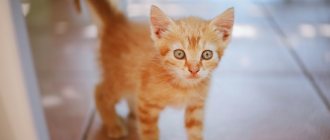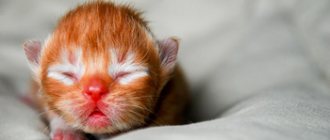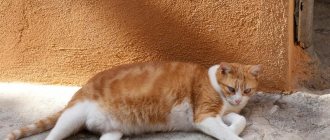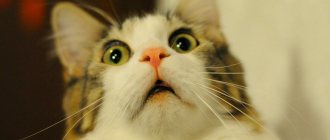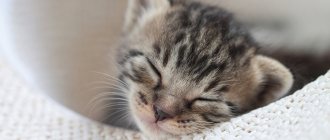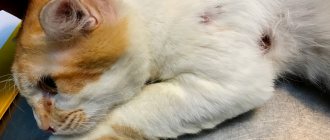When kittens begin to move in the belly of a pregnant cat, this indicates that the pregnancy itself is proceeding without problems, which is why it is important to monitor the condition and behavior of the pet, especially if she is bearing offspring for the first time. Typically, movement occurs at 6 weeks, when the kittens' muscular and nervous systems are developing. In this way they warm up the motor system.
Are you my brother or not my brother?
After 15 days , the placenta is formed, through which the necessary substances enter and waste products of the future offspring are eliminated. After 20 days, the embryo takes on a C-shape, from which the tail, body and head will appear.
Position of kittens in a cat's stomach
Even if kittens are born to the same cat at the same time, their fathers may be different.
This is caused by excessive mating of the mother cat with different cats. Determining the father of the family by the general distinctive feature of kittens is quite problematic.
Organ formation in kittens
Kitten embryo 17-18 days
By day 21, the embryos reach the size of a grape and at this stage, like other mammals, including humans, look the same. The first organs begin to form. During this period, the cat becomes aware of the upcoming motherhood and begins to prepare for the role of mother. Her nipples grow and she may even feel sick in the morning, just like women.
How is pregnancy progressing?
If the owner notices that the pet sleeps a lot, its activity decreases, its nipples become pink and sometimes vomits, it is most likely pregnant. Usually signs appear in the 3rd week after mating. Pregnancy is determined by palpation, but a veterinarian can finally establish this fact. It is important to remember that after 21 days the kitty’s tummy fills with fluid and it is more difficult to palpate the kittens, or even harm them.
Gestation lasts from 58 to 72 days, but the timing may depend on the breed: long-haired breeds carry babies for 62-72 days, and Scottish and British breeds - 63-67. In breeds with short hair, the process takes 58-68 days.
The total duration of pregnancy is 2 months and occurs in several stages:
By 9 weeks, the fruits are ready to be born, as they are fully formed.
- Attachment of the embryo to the wall of the uterus. This usually happens on days 11-13.
- After 2 weeks, the placenta forms, thanks to which the fetus receives nutrients.
- Vital organs are formed within 10-24 days. Starting from the 3rd week, the pet may experience toxicosis, mood swings and worsening appetite.
- On day 20, the embryo takes shape, it has ears, a tail, and a head.
- Weeks 5-6 are marked by the development of the toes, the appearance of skin and fur. The nervous system and muscles, organs of touch, smell and senses develop.
- At 7-8 weeks, the kittens’ movements increase, which is felt by the expectant mother, and therefore she is in search of a calm and comfortable place to give birth.
- By week 9, the kittens’ small bodies are fully formed, which means the whiskers are ready for birth.
First steps"
The embryos develop very quickly and in the fifth week the strongest sense organs begin to develop, which are the key to the success of cats.
Hearing (moving ears)
One of them is hearing. There are 30 muscles around the ears, whereas a person has 6. They rotate the ear 180 degrees, like a satellite dish, pointing it in the direction of noise.
Cats can hear mouse footsteps from a distance of 9 meters and even hear ultrasound. Even in the womb, they hear and react to what is happening.
We start to move - it's time to train
Closer to the 6th week , depending on the breed and number of offspring, approximately 38 days , the nervous and muscular systems of unborn kittens begin to develop rapidly.
Kittens exercise in mother cat's tummy
Tiny fetuses are trying to train their skills and begin their first movements, which they need after birth: they stretch, scratch with their paws and seem to catch up with an imaginary target. Fighting for free space in the uterus, they push, push, fumble and bang their heads.
And when the kittens begin to move, then after 13-14 days it is time to prepare for the adoption of offspring.
The cat becomes restless, the kids disturb her with their activity. Since the sensory organs of the embryos are already formed, they react to loud sounds and anxiety of the cat. Cats begin to look for a secluded place and avoid communication, so as not to disturb the unborn, but already restless offspring.
What if the kittens don't move?
The babies push and move, which means the pregnancy is proceeding smoothly and the cat will soon give birth, but it happens, on the contrary, when the tummy is round and no movement is visible at the right time. There may be a normal explanation for this. Active actions can be observed several days before the onset of labor, if the pet has a well-fed or large build, and there are 1-2 fluffies in the womb, then the kittens are located mainly under the sternum, which is high and it is difficult to observe their movement. In addition, in different breeds of cats, movement begins later by a week or 2, especially if the exact date of mating is unknown.
Visible movements of kittens in the belly of a pregnant cat
Even through the fur it is possible to see the swaying belly of the expectant mother and feel the heads of the kittens. But it is quite difficult to determine the number in the litter. The not yet born fidgets with their movements throw off the entire count. In addition, cats are reluctant to let even their owner near their belly.
On the 50th day, the kittens are fully formed and endowed with all the characteristics inherent in them in the future.
Approximately day 52
On day 52, they begin to simulate breathing by opening their mouths and inflating their chests. Amniotic fluid enters the mouth and the kitten begins to hiccup. Then, as scientists observed, he brings his paws to his mouth, imitating washing himself.
Cats spend about one-sixth of their life washing. Like a comb, they use their tongue to remove all traces and odors that could scare away prey during the hunt.
Planning a cat's pregnancy
If you plan to breed a purebred cat, you should find out in advance whether the resulting offspring will improve the breed (or at least not significantly worsen it). In the case of irresponsible crossing of purebred cats, the appearance of animals becomes more frequent, not only outwardly not meeting breed standards, but also with changes in the skeletal structure that make life difficult for cats, hereditary diseases, and sometimes even a tendency to aggression is transmitted. Find out in advance from your veterinarian what hereditary diseases cats of the same breed as yours are prone to, and conduct the appropriate research to protect future offspring from trouble.
If you decide that the risk justifies the appearance of kittens, and in the case of breeding purebred animals, you find out that your beauty’s family consists of healthy offspring, then to ensure safety, you need to plan everything carefully. For both outbred and purebred cats, there is a danger of contracting some serious infectious diseases during mating. Therefore, veterinarians do not recommend that even outbred animals become pregnant from mating with an “unknown gentleman”; it is better if the male with whom mating is planned has been tested for such infections, has been treated for worms, vaccinated with a complex vaccine and has undergone a general examination by a veterinarian.
Harbingers of childbirth
Harbingers are considered to be changes in the animal’s vital activity within 24 hours before birth. The cat's uterus is arranged in the shape of the letter “Y” - the “horns” are the place of the kittens, the “tail” is the cervix. The main changes occur precisely in it, accompanied by discomfort or pain. Miscarriage and spontaneous childbirth are accompanied by the same symptoms, with one difference. Signs of premature birth in a cat most often occur 1-2 times faster.
As soon as you notice your cat's anxiety, pay attention to the following aspects:
- Most often, before the onset of contractions, a mucus plug comes out of the cervix - a small clot of a transparent, yellowish, greenish color, small brown inclusions are considered normal. You need to understand that the cork’s rejection may not be noticed. It can come out during urination or be torn off in parts - the cat licks itself, the discharge is unnoticeable.
- During pregnancy, kittens lie according to the “compact” principle, and for proper birth they need to turn around with their heads down. Large “babies” may not have time to do this, but during the process there is active movement of the fetuses - the kittens turn and push, causing a lot of inconvenience to the mother.
- The first contractions are barely noticeable, but can be felt if you put your palm on the cat’s stomach - the opening of the cervix begins, the process can take up to 8 hours.
Preparedness #1! Signs of an imminent birth in a cat are strong contractions, noticeable without palpation, the cat lies on its side or squats and arches its back - in the period from 5 to 60 minutes the first “baby” will appear.
How does the feline birth process work?
Cats bear offspring for about 64 days, in rare cases - up to 70 days. On average, there are 3-5 kittens in a litter, but cases of the birth of eight cat cubs have been recorded. The duration of labor is influenced by several factors: age, number of fetuses, number of previous lambings, breed, diet during pregnancy. On average, the process of childbirth in cats takes from several hours to a day and a half, and includes periods of contractions, pushing and expulsion of the fetus.
The cat's first contractions may be invisible to others because they are still weak. At this time, your pet can be busy arranging the nest. As the contractions intensify, the cat may moan, meow, and its body periodically tenses in efforts. Then the cervix opens, the mucous birth plug emerges through the birth canal, followed by the first kitten.
Kittens are born “in order”, usually with a break of half an hour to 12 hours. Their birth may alternate with the expulsion of the placenta, which the cat sometimes eats. Kittens are born in the embryonic membrane (amniotic sac), the cat chews it, licks the cub, then bites the umbilical cord. The mother can begin feeding already born kittens in between contractions.
If your pet ignores the newborn kitten, the owner present at the birth will have to open the amniotic sac himself, carefully wipe the kitten and place it next to the mother. During the birthing process, your cat may need several hours of rest.
It is difficult for an inexperienced cat owner to understand whether all the kittens have already come out, or whether this is a break in childbirth. Even an ultrasound scan performed during pregnancy does not always reliably determine the exact number of fetuses. You can focus on the signs of the end of the birth process
During the birthing process, your cat may need several hours of rest. It is difficult for an inexperienced cat owner to understand whether all the kittens have already come out, or whether this is a break in childbirth. Even an ultrasound scan performed during pregnancy does not always reliably determine the exact number of fetuses. You can focus on the signs of the end of the birth process.
Methods for assessing the “adequacy” of fetal movements
Counting the number of movements
The easiest way to assess fetal movements is to count the number of movements by the pregnant woman herself. Self-assessment methods are very easy to use, do not require additional equipment or the presence of a doctor, and are easily reproduced by any woman. Their disadvantages are that each woman has different thresholds of susceptibility.
"Count to Ten"
The most common method for assessing fetal movements is called “count to ten” . It can be performed after 28 weeks of pregnancy, when the fetus is mature enough for active movements. Its essence lies in the fact that the expectant mother counts the movements of the fetus over a 12-hour period of time, for example from 9 am to 9 pm. The time when the pregnant woman detects the tenth movement is recorded on a tablet. If the fetus makes less than 10 movements in 12 hours, this is a reason to consult a doctor for further examination.
Sadowski method
In the evening after dinner (approximately from 19 to 23 hours), the woman lies on her left side and counts the movements of the fetus. At the same time, everything is counted, even the smallest movements. If 10 or more movements are noted within an hour, this indicates that the baby is moving quite actively and feels well. If the fetus moved less than 10 times in an hour, then the movements are counted over the next hour. The evening time for this assessment method was not chosen by chance. It is in the evening hours, especially after dinner and the associated increase in glucose, that the greatest activity of the fetus is observed. If the number of fetal movements during this test is less than 10 in two hours, this should be considered as a sign of a violation of its condition and additional research should be carried out.
For an obstetrician-gynecologist, fetal movements are also an important diagnostic criterion for certain deviations in the course of pregnancy from the norm. Too active, violent, painful movement of the fetus or weak, infrequent movements may indicate its unfavorable condition.
Pregnancy in cats
Personally, at this stage, fate has rewarded me with two male furry paws, so the happiness of cat motherhood does not threaten me. But this is not a reason not to understand the intricacies of the feline process of pregnancy and reproduction.
Usually, owners of domestic cats sterilize to avoid possible pregnancies, not to bother with the distribution of kittens, and to save the cat from suffering and diseases associated with the feline reproductive system.
But if you are sure that your “valuable fur” has unique characteristics of nature and breed and you really want striped, furry grandchildren, then it is better to approach the issue of cat pregnancy with all responsibility.
Preparing for childbirth, behavioral changes
If the pregnancy is normal and there are no health problems, by the 50th day of pregnancy the following set should be prepared in the house:
- Sturdy box with low side. The cat should freely enter and exit the “nest” without clinging to the side with its belly.
- Several pairs of sterile, latex surgical gloves.
- Medical pipettes or suction, for forced cleaning of the respiratory tract if the kitten does not cough on its own.
- Sterile or boiled thread.
- Surgical or antiseptic-treated cosmetic scissors.
- Liquid and powder antiseptics purchased at a veterinary pharmacy. Human medications can be toxic to mother and kittens.
- Zelenka and cotton swabs for lubricating the umbilical cord.
- Clean cotton diapers, flannel. Several small terry towels for rubbing kittens.
- Levomikol ointment or an analogue - in case of stoppage of fetal movement in the birth canal.
- Clean water bowl.
- Powdered infant formula from 0 months is a cat milk substitute.
- Pre-agreed conditions for the veterinarian’s visit and a telephone number for remote consultation.
- Oxytocin or an analogue – stimulation of contractions and labor.
- Sulfocamphocaine – stimulation of cardiac activity.
- Potassium gluconate – support in case of prolonged labor. A solution of up to 10% can be administered subcutaneously; above that, only intravenously!
False pregnancy in a cat
Usually, after mating, the cat becomes pregnant
The behavior of the pet and some signs confirm the interesting position of the animal: swelling of the mammary glands, caution of the female in behavior, enlargement of the abdomen. But after 3 or 4 weeks all symptoms disappear
This is called a false pregnancy, which is actually a hormonal imbalance in the cat's body. This negatively affects the animal's psyche.
The reasons for the occurrence of false pregnancy lie not only in hormonal imbalance: perhaps the mating was with a sterile cat, or the female’s body has pathologies of the reproductive system, disorders of the thyroid gland.
Treatment includes a diet and a reduction in the amount of dairy products in the pet’s menu, which will have a positive effect on the cat.
It is important to show attention to the injured cat and surround it with care. It is advisable to add vitamins to food
Injections for cats from pregnancy
Not all owners want to get offspring from their pet. To prevent cat pregnancy, special injections have been developed, prescribed according to a regimen selected by the veterinarian.
The injection is given before the onset of estrus, and the effect of the hormonal agent is effective for 6 months. Afterwards, a new dose of the drug will be required.
This is a kind of sterilization, simple to use, and leaving the cat the opportunity to bear offspring after the drug wears off.
This method has disadvantages: dysfunction of the reproductive system, health complications including inflammation and cancer.
Critical course of labor
We must call the veterinarian if:
- Childbirth is delayed by more than 10 days.
- The kitten remains in the birth canal for more than 30 minutes.
- More than 5 strong attempts without the kitten exiting the birth canal.
- 10 minutes of strong contractions with squeezing the amniotic sac into the birth canal.
- Increased temperature or fever.
- Copious discharge of scarlet or dark brown color, “putrid” smell of discharge.
